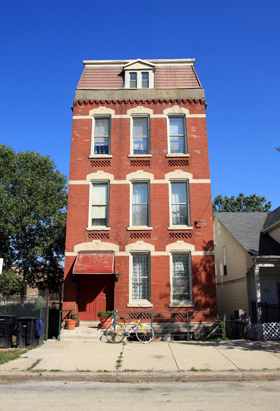
Interview with a Gentrifier
Young Bohemians and gentrification in Chicago’s Pilsen neighborhood
In 2008 the College began publishing an annual academic journal, Chicago Studies, to showcase undergraduate work on Chicago history. The 2009 issue included five papers on such topics as the preservation of historic Pullman and the development of the “Chicagoan accent.” Below is an excerpt of Anh-Thu Huynh’s paper. The list of works cited is published in full.
Seeking Authenticity in Chicago’s Pilsen: Toward a More Nuanced Understanding of Gentrification
By Anh-Thu Huynh, AB’08
 Foreword
Foreword
I chose Pilsen as my neighborhood of study because it seemed to be where all of my coolest friends went on the weekends. Before this project all I knew was that it was Chicago’s Mexican neighborhood, and had a reputation for being “artsy.” I also thought that it was close enough to Hyde Park that it would be easy to access (wrong!). Once I began to do some fieldwork and interviews, it became apparent that I was ill-equipped to discuss everything that I had observed.
“Gentrification” has its own complicated history. It’s inextricably tied to race and class, two loaded topics that I did not feel ready to confront, particularly against the backdrop of Chicago’s notorious history of segregation. I chose to deal with this by focusing on what my interview subjects, who are all undeniably “gentrifiers,” had to say about their choices, why they made them, and, perhaps most significantly, how they felt about the roles that they might be playing in neighborhood change. I got a lot of interesting answers, some expected and some surprising.
For my subjects, the primary appeal of Pilsen was not its low rents or how “hip” or “gritty” it seemed, but rather, the authenticity it could offer. The choice to gentrify can be read as a conscious (and often self-conscious) act of rebellion against the anomie and alienation characteristic of modern urban living, the expression of a “fantasy that the experience of an idealized reality might render our lives more meaningful” (Grazian 2003 241).
A brief history of Pilsen
Pilsen is one of the oldest communities in Chicago’s Lower West Side. By 1875 it was one of Chicago’s major industrial centers, home to rail yards, manufacturing plants, lumberyards and breweries. Immigrants from Bohemia were its earliest settlers, naming the community for their homeland’s second-largest city.
During the 1950s and early 1960s, Mexican families began to move to Pilsen. While Pilsen’s population was only 0.5 percent Mexican in 1950, in 2000 this number hovered somewhere around 89 percent. More than half of Pilsen’s homes were built between 1885 and 1895, with many dating from even earlier decades.
The original Pilsen East Artists Colony at 18th Street and Halsted was established in the 1960s, and since then the area has been transformed into a bustling commercial street, boasting galleries and coffee shops. The neighborhood changes of recent years have spurred much discussion about Pilsen’s future.
Theories of gentrifications and globalization
While there are undeniably structural reasons behind neighborhood choice—proximity to social networks, ease of transportation, and rent rates being the most obvious—I found that surprisingly, these factors did not seem like the primary reasons the people I interviewed chose to move.
When I tried to uncover the other aspects of neighborhood choice, responses could be broken down into three main categories: identity formation, the desire for a sense of history, and a longing for community. These categories can all be contained within a broader theme: the search for authenticity in the city.
